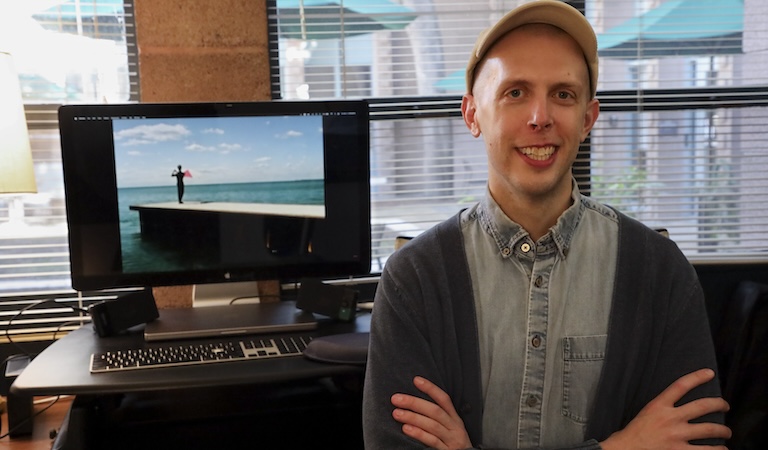Harvey Mudd Professor David Seitz Receives OutHistory Fellowship
April 16, 2024
David Seitz, associate professor of cultural geography, has been awarded a $1,500 fellowship from the OutHistory Foundation for an essay project, “Enough is Enough: The Politics, Passion, and Poetry of Pei-Hsien Lim,” to be published in 2025. OutHistory is a public history website that features historical research for LGBTQ and general audiences, with a special interest in underrepresented histories and historical research that contributes to social change.
Pei-Hsien Lim (1953–1992), known as Pei Lim, was a Malaysian-Chinese-Canadian artist and social justice activist in LGBTQ, PWA (people with AIDS) and Asian North American communities. Seitz’s essay project, accompanied by multimedia artifacts, chronicles Lim’s political and artistic contributions to these movements and considers how Lim’s work enacted social change during his life and influenced contemporary social activism.
The inspiration for Seitz’s project came from Track Two, a documentary released in 1982 on community responses to Operation Soap, a 1981 Metropolitan Toronto Police raid at four gay bathhouses in the city. During the raid, nearly 300 men were arrested—many under brutality—making it among the largest mass arrests in Canadian history. Track Two chronicles how a multiracial coalition of Toronto activists and artists, appalled by the injustice, united to demand change. “When I was a graduate student at the University of Toronto, I wanted to revisit Track Two, which was re-released in 2011, to ask how contemporary discussions of police violence against sexual and racial minorities might both extend and learn from this history,” says Seitz.
Seitz says that Track Two’s final scene, iconized in the documentary’s promotional poster, sent a particularly powerful message: “As the camera looks to the horizon over Lake Ontario, we see a man crouched on a dock who picks up a pink triangle flag, symbolizing gay liberation, and begins to perform a dance with strong, graceful movements,” says Seitz. “And as the camera gets closer, it’s apparent the man is a person of color. Just fifteen years after Canada’s immigration laws became more open to people from Africa, Latin America and Asia, and a little over a decade after sex between consenting adult men was decriminalized, this film made a gay man of color its standard-bearer for gay liberation, a figure at the horizon who represents a hopeful future for Toronto.”
Track Two left Seitz curious about the man on the dock. After some investigation, he learned that the man’s name was Pei Lim, and that he had also appeared as an interview subject as well as a dancer in several documentaries by the celebrated Chinese-Trinidadian-Canadian filmmaker Richard Fung. Lim, who worked a range of jobs—nurse, art director, flight attendant—also played a formative role in the development of several organizations creating community for LGBTQ Asians and responding to HIV/AIDS in both Toronto and Vancouver. Alongside this professional and community work, Seitz says, Lim was a prolific artist. “Lim’s multidisciplinary art practice—as a sculptor, painter, poet, model, dancer, even an adult entertainer—reflects on many of the challenges he experienced as an activist and in ordinary life as a minority among minorities,” say Seitz.
While on sabbatical in 2023, Seitz returned to Toronto and visited The ArQuives, among the world’s largest LGBTQ2+ archives. There, he found traces of Lim’s work in the files of Fung, Fung’s partner Tim McCaskell, and other artists and activists, including 40 pages of largely unpublished poetry Lim wrote in the final year of his life before he died of AIDS in 1992. “In reading Lim’s poetry, you can tell he had strong convictions about both the necessity and the limits of community organizing and nonprofit organizations,” says Seitz. “There are moments of searing criticism and moments of tremendous compassion and generosity.”
Yet Seitz also noticed that Lim remains surprisingly underdiscussed in academic scholarship. “Despite decades of work by scholars to both celebrate and critically evaluate the legacies of LGBTQ and HIV/AIDS activists of color—including the important work of other Claremont Colleges faculty like Scripps Professor Jih-Fei Cheng—there remain huge gaps in scholars’ knowledge about the work by grassroots activists like Lim who devoted their lives to gender and sexual equality, anti-racism, and justice and care for HIV-positive people and people with AIDS. What scholars recognize as legitimate knowledge about these histories directly shapes what our students learn,” says Seitz.
Seitz began speaking to more people who knew Lim in his final years of life and heard powerful stories that pieced together a portrait of a staunch social rights, civil liberties, anti-racism and HIV/AIDS activist. “These conversations, coupled with troubling renewals of anti-LGBTQ and anti-Asian sentiments in North America and elsewhere, gave me a sense of urgency to shed more light on Lim,” Seitz says.
At Mudd, Seitz teaches courses on a range of topics, from Star Trek to public health, all of which reflect on questions of race, class, gender and sexuality. In Geographies of Disease and Health Justice, Seitz guides students to think intersectionally about how race, class, gender and sexuality are linked social determinants of health and how they inform broader responses on health issues such as HIV and COVID-19. “That’s something Lim was modeling and was way ahead of his time in doing so,” says Seitz. “He got a doctor to offer a traditional Chinese medicine clinic for people with AIDS. He started a qi gong class for people with AIDS. I’ve had some wonderful Mudd students who’ve gone on to work in these fields who tell me that public health practitioners still have a lot to learn from what social activists like Lim were advocating for in the 1980s.”
